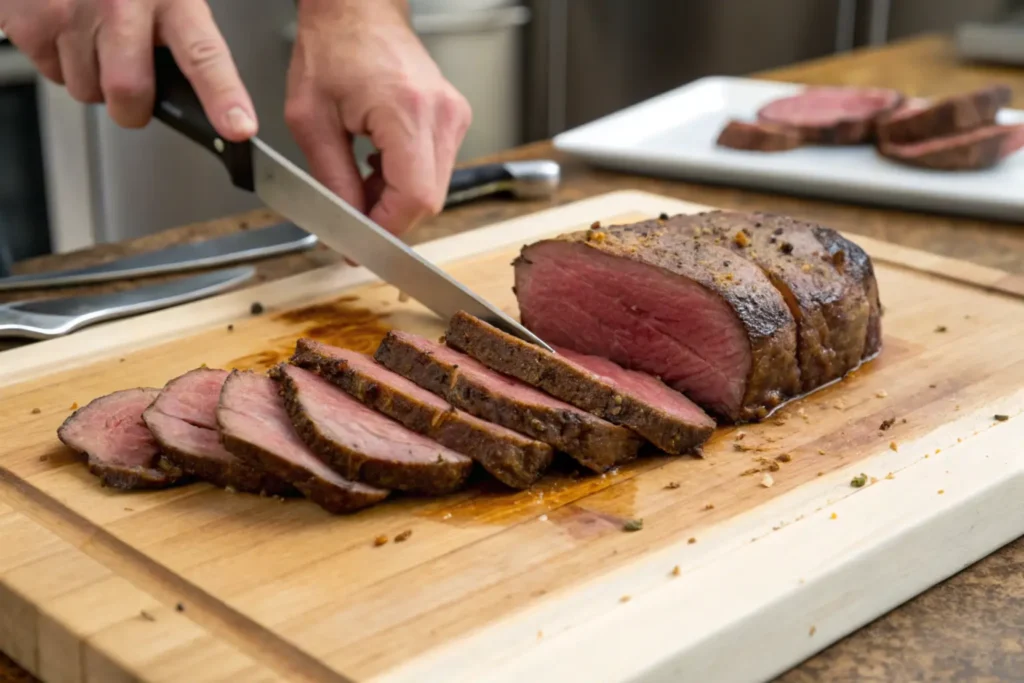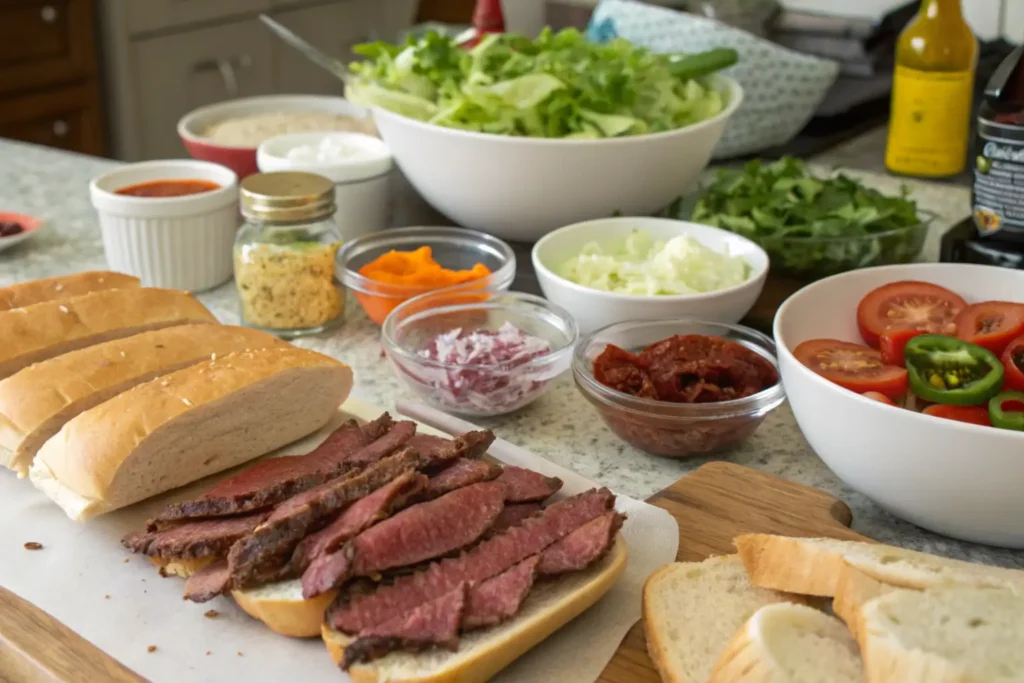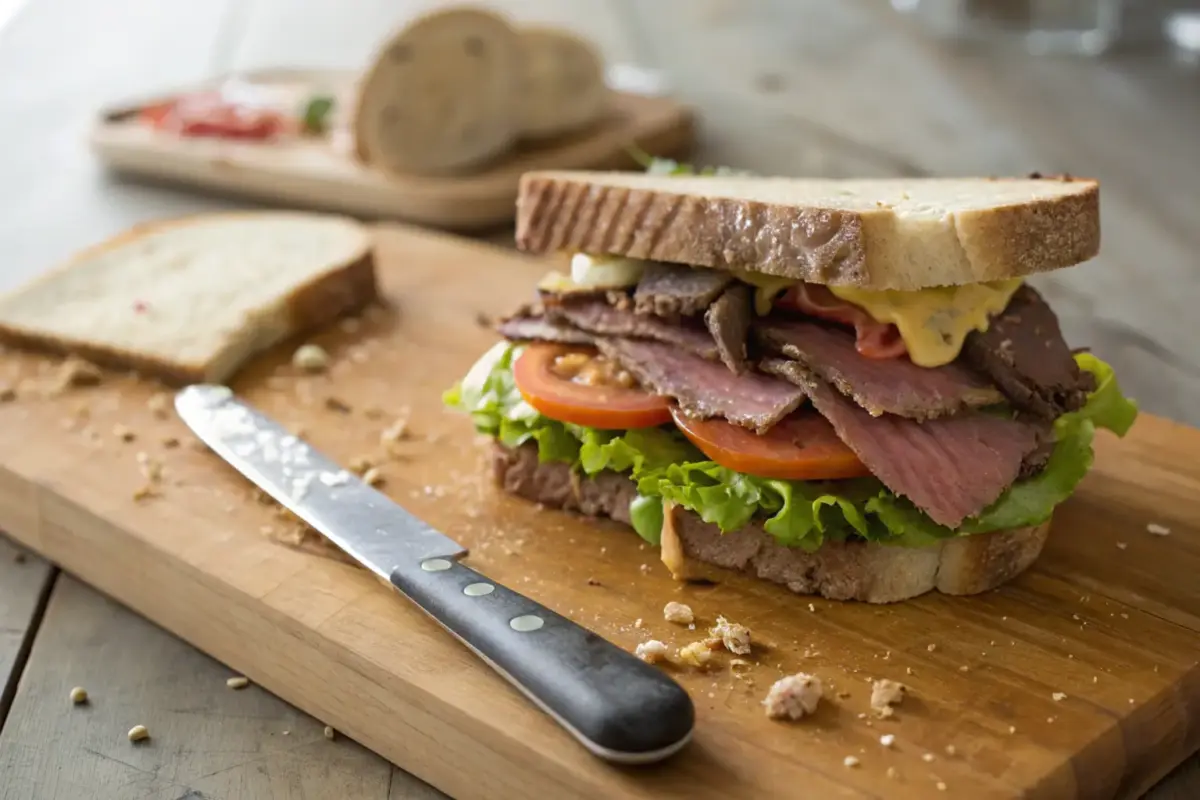Introduction
Let’s talk about sandwiches—the kind that makes you stop mid-bite to appreciate just how good it is. If you’re a fan of beef sandwiches, you already know the cut of beef can make or break the whole thing. Honestly, the right cut doesn’t just add flavor; it defines the entire experience. Whether you’re going for a stacked roast beef sandwich or a sizzling steak sandwich, the beef has to be on point.
Beef sandwiches come in all shapes and sizes—think Philly cheesesteaks, classic roast beef on rye, or even a gourmet steak sandwich with fancy toppings. No matter your style, picking the right beef is step one to making it amazing. So, let’s break down the basics of beef cuts and how they play into crafting the perfect sandwich.
Beef Primal Cuts
What Are Primal Cuts?
Primal cuts are the big sections of beef that are divided first when processing the animal. These cuts are like the foundation of all other cuts, so understanding them gives you a solid starting point. When it comes to sandwiches, certain primal cuts—like chuck, rib, loin, and round—stand out because of their flavor, texture, and versatility.
Primal Cuts Perfect for Sandwiches
For sandwich-making, the primal cuts you’ll want to know are:
- Chuck: Known for its rich flavor and tenderness when slow-cooked.
- Rib: The source of juicy, marbled cuts perfect for steak sandwiches.
- Loin: Home to tender cuts like strip steak or tenderloin.
- Round: Lean and affordable, great for roast beef sandwiches.
Explore what goes well with beef in a sandwich to pair the perfect accompaniments with your chosen beef cut.
Subprimal Cuts
What Are Subprimal Cuts?
Subprimal cuts come from the primal sections we just talked about. They’re smaller, more specific cuts of meat that give you flexibility for different recipes. For sandwiches, these are the cuts that let you dial in exactly what you want—whether it’s bold flavor, tenderness, or easy slicing.
Why Subprimal Cuts Matter for Sandwiches
When you’re making a beef sandwich, you need meat that’s easy to work with and delivers on taste. Subprimal cuts like bottom round or eye of round are perfect for slow-roasting, while others like ribeye bring that melt-in-your-mouth quality to steak sandwiches. Picking the right subprimal cut lets you tailor your sandwich to your mood—or the crowd you’re feeding.
For inspiration on another beef-focused dish, check out the difference between chopped beef and cheesesteak and how they use different cuts.
Top Choices for Roast Beef Sandwiches
Bottom Round Roast
When it comes to roast beef sandwiches, bottom round roast is the star of the show. It’s a lean cut with just enough flavor to keep things interesting, and it slices beautifully when cooked right. The key is slow roasting it to medium-rare and letting it rest before carving thin slices. This cut pairs well with tangy sauces or a classic au jus dip for that full roast beef sandwich experience.
Top Loin Roast (NY Strip)
The top loin roast, also known as New York strip, brings a little more richness to the table. With its balance of marbling and bold flavor, it’s a step up from leaner cuts. Cook it to medium or medium-rare, and you’ve got yourself a juicy centerpiece for your sandwich. It’s perfect for sandwiches that need a bit of indulgence—think thick cuts paired with horseradish or caramelized onions.
Eye of Round
The eye of round might not win any awards for tenderness, but it’s a fantastic budget-friendly option. It’s lean and works best when slow-cooked to preserve its flavor and texture. Slice it thinly against the grain, and you’ll have a satisfying roast beef sandwich that doesn’t break the bank. Add some crunchy pickles or mustard for an extra kick.
Best Cuts for Steak Sandwiches
Ribeye
Ribeye is the king of steak sandwiches. Its marbling creates a juicy, melt-in-your-mouth experience that’s hard to beat. Grill or pan-sear it to medium-rare for maximum flavor, then slice it thinly for your sandwich. A ribeye steak sandwich is all about indulgence, so load it up with sautéed mushrooms, onions, and a gooey cheese like provolone or mozzarella.
Sirloin
If ribeye is a little too pricey, sirloin is a fantastic alternative. It’s flavorful, versatile, and easier on the wallet. Sirloin works well when grilled or broiled, and slicing it thin against the grain keeps it tender. Pair it with fresh greens, a slice of tomato, and a zesty sauce for a steak sandwich that’s fresh and satisfying.
Learn more about what chopped beef sandwiches bring to the table and how they differ in preparation and flavor profile.
Tenderloin
Tenderloin is a luxury cut, but it’s worth considering for special occasions. It’s buttery and incredibly tender, making every bite feel like a treat. Because it’s so mild in flavor, it pairs well with bold sauces like chimichurri or blue cheese dressing. Slice it thin and serve it on a crusty baguette for a sandwich that’s pure decadence.
Alternative Cuts for Unique Sandwiches
Flank Steak
When it comes to bold flavor and versatility, flank steak is a fantastic option for sandwiches. First and foremost, its rich, beefy taste stands out in any recipe. However, because it’s a lean cut, cooking it correctly is essential to prevent it from becoming tough. Flank steak works best when cooked quickly over high heat, such as grilling or pan-searing. The high temperature creates a flavorful crust while keeping the interior tender and juicy.
Once it’s cooked, slicing is the next critical step. To ensure tenderness, always slice flank steak thinly and against the grain. This technique shortens the muscle fibers, making each bite easy to chew. Additionally, flank steak pairs beautifully with a variety of toppings and sauces. For instance, roasted peppers, caramelized onions, or a drizzle of chimichurri sauce can bring out its robust flavor. As a result, sandwiches featuring flank steak become both satisfying and unforgettable.
Finally, choosing the right bread can take your flank steak sandwich to the next level. A hearty option like ciabatta or a toasted baguette holds up well against the juicy steak and flavorful toppings. By paying attention to every detail—from cooking to slicing to pairing—flank steak easily proves itself as a strong contender when deciding what cut of beef is best for sandwiches.
Tri-Tip
Tri-tip is a versatile cut that’s perfect for grilling or roasting. Its slightly smoky, beefy flavor makes it a favorite for barbecue-style sandwiches. Slice it thin and stack it on a sandwich with barbecue sauce and coleslaw, and you’ve got yourself a crowd-pleaser that’s both hearty and delicious.
Chuck Roast
Chuck roast is a fantastic choice for slow-cooked, shredded beef sandwiches. It’s affordable and incredibly flavorful when cooked low and slow. Use it for pulled beef sandwiches with a savory sauce, or pair it with melted cheese for a classic French dip. It’s a versatile option that works great for feeding a crowd.
Cooking Techniques for Beef Sandwiches

Preparation Methods
When deciding what cut of beef is best for sandwiches, preparation methods play a huge role in the final result. For lean cuts like bottom round or eye of round, roasting is a top choice. This method uses low, even heat to cook the beef gently, preserving its tenderness and flavor. A perfectly roasted beef makes for thin, juicy slices that are easy to layer onto your sandwich. Marbled cuts, such as ribeye, thrive with grilling or pan-searing. The high heat creates a beautiful sear, locking in juices and delivering a flavorful crust. Always cook ribeye to medium-rare for the best balance of tenderness and flavor.
If you’re working with tougher cuts like chuck roast or brisket, braising is the go-to technique. This slow-cooking method allows the beef to absorb flavors from broths or marinades while breaking down connective tissues, creating tender, pull-apart meat perfect for shredded beef sandwiches. Chuck roast braised in savory spices or barbecue sauce is a crowd-pleaser for sandwich lovers everywhere.
Slicing Techniques
The way you slice your beef is just as important as how you cook it. To get the most out of your chosen cut, always slice against the grain. This technique shortens the muscle fibers, making the beef more tender and easier to chew—especially important for sandwich slices. For cuts like flank steak or brisket, thin, even slices are key to avoiding a chewy texture.
Let the beef rest after cooking before slicing. Resting helps the juices redistribute throughout the meat, ensuring every bite is juicy and flavorful. Whether you’re working with roasted bottom round or braised chuck roast, taking the time to slice properly will elevate your sandwich game. By combining precise slicing techniques with the right cooking method, you’ll understand exactly what cut of beef is best for sandwiches that leave a lasting impression.
Pairing Ingredients with Beef Sandwiches

Breads
When deciding what cut of beef is best for sandwiches, it’s equally important to pair it with the right bread. The bread serves as the foundation, bringing everything together. For roast beef sandwiches, crusty options like sourdough or French baguettes work wonders. These breads hold up well against juicy fillings and sauces without becoming soggy. Steak sandwiches, on the other hand, shine with softer breads like ciabatta or brioche. These choices are sturdy enough to contain the fillings while adding a rich, indulgent touch.
If you’re making shredded beef sandwiches with cuts like braised chuck roast, hoagie rolls or kaiser buns are perfect. These breads provide structure and a slight chew, making them ideal for containing tender, saucy fillings. Don’t overlook toasting the bread—it enhances flavor and adds a satisfying crunch. Whether you choose crusty or soft bread, pairing it thoughtfully with your beef cut elevates the sandwich experience.
Condiments and Toppings
The condiments and toppings you select can make or break your sandwich, especially when showcasing what cut of beef is best for sandwiches. For roast beef sandwiches, creamy horseradish or Dijon mustard adds a tangy contrast that highlights the beef’s natural flavors. Steak sandwiches are elevated with sautéed onions, mushrooms, and melted cheeses like provolone or Swiss, adding a savory depth.
Fresh vegetables are another excellent addition. Crisp lettuce, arugula, and thinly sliced tomatoes bring brightness and balance to rich beef cuts. To add a zesty pop, include pickles or banana peppers—they cut through the heaviness of the meat and cheese. For barbecue-style shredded beef sandwiches, a dollop of creamy coleslaw provides crunch and complements the smoky flavors. By carefully selecting condiments and toppings, you can enhance the flavors of your chosen beef cut and create a sandwich that’s truly unforgettable.
FAQs Section
What is the most tender cut of beef for sandwiches?
If tenderness is your priority, you can’t go wrong with the tenderloin. This cut is buttery soft and melts in your mouth. However, it’s also one of the most expensive options. For a more budget-friendly choice, bottom round or sirloin works well when sliced thin and cooked properly.
How do I cook beef for sandwiches?
The cooking method depends on the cut you’re using. For lean cuts like bottom round, roasting at a low temperature ensures tenderness. Marbled cuts like ribeye benefit from grilling or pan-searing, which enhances their flavor. And for tougher cuts like chuck roast, braising is the way to go—it’s the secret to perfect shredded beef.
Can I use leftover beef for sandwiches?
Absolutely. Leftover beef can make some of the best sandwiches. Simply slice or shred it, warm it up gently, and pair it with fresh bread and toppings. Whether it’s leftover roast or steak, repurposing beef for sandwiches is a quick and delicious solution for a next-day meal.
What are some budget-friendly cuts for beef sandwiches?
Chuck roast, bottom round, and eye of round are all great options that won’t break the bank. These cuts deliver robust flavor when cooked correctly and are versatile enough for various sandwich styles. They’re perfect for feeding a crowd without sacrificing quality.
Conclusion
Creating the perfect beef sandwich is a mix of choosing the right cut, mastering the cooking technique, and pairing it with the best ingredients. So, what cut of beef is best for sandwiches? The answer depends on what you’re craving—lean cuts like bottom round for a classic roast beef sandwich, or marbled cuts like ribeye for a juicy steak sandwich. The possibilities are endless when you combine these elements thoughtfully. By experimenting with different combinations of bread, condiments, and toppings, you can discover a world of flavors that suit your taste. So the next time you’re craving a beef sandwich, take your time and enjoy the process—you’ll thank yourself with every bite.


1 thought on “What Cut of Beef is Best for Sandwiches? A Complete Guide”